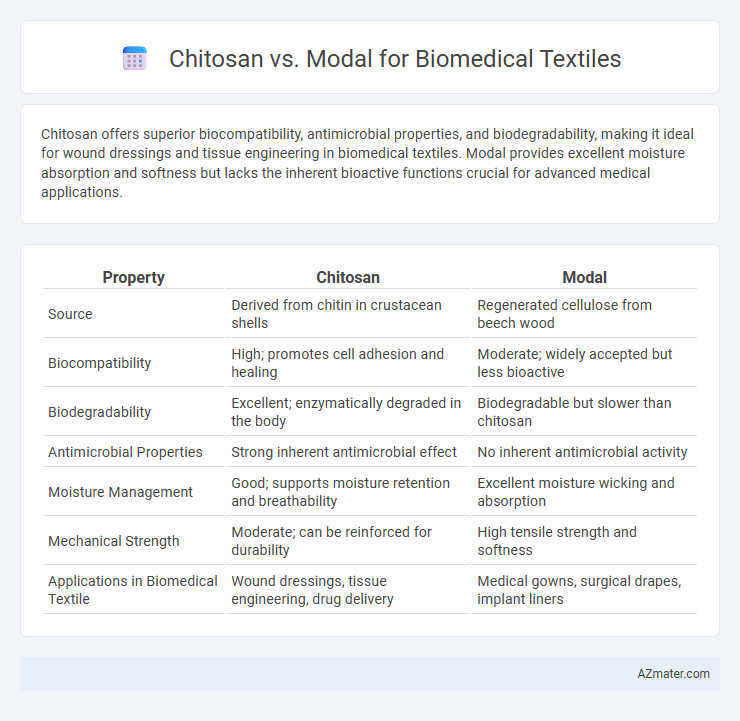Chitosan offers superior biocompatibility, antimicrobial properties, and biodegradability, making it ideal for wound dressings and tissue engineering in biomedical textiles. Modal provides excellent moisture absorption and softness but lacks the inherent bioactive functions crucial for advanced medical applications.
Table of Comparison
| Property | Chitosan | Modal |
|---|---|---|
| Source | Derived from chitin in crustacean shells | Regenerated cellulose from beech wood |
| Biocompatibility | High; promotes cell adhesion and healing | Moderate; widely accepted but less bioactive |
| Biodegradability | Excellent; enzymatically degraded in the body | Biodegradable but slower than chitosan |
| Antimicrobial Properties | Strong inherent antimicrobial effect | No inherent antimicrobial activity |
| Moisture Management | Good; supports moisture retention and breathability | Excellent moisture wicking and absorption |
| Mechanical Strength | Moderate; can be reinforced for durability | High tensile strength and softness |
| Applications in Biomedical Textile | Wound dressings, tissue engineering, drug delivery | Medical gowns, surgical drapes, implant liners |
Introduction to Biomedical Textiles
Chitosan and modal are prominent materials in biomedical textiles due to their unique properties that enhance tissue engineering and wound healing applications. Chitosan, a natural polymer derived from chitin, offers biocompatibility, biodegradability, and antimicrobial effects, making it ideal for medical bandages and implants. Modal, a semi-synthetic cellulose fiber, provides excellent moisture management and softness, improving patient comfort in wound dressings and surgical textiles.
Overview of Chitosan Fibers
Chitosan fibers, derived from chitin found in crustacean shells, exhibit excellent biocompatibility, biodegradability, and antimicrobial properties, making them ideal for biomedical textile applications such as wound dressings and tissue engineering scaffolds. Their natural polymer structure promotes cell adhesion and accelerates healing processes, offering advantages over synthetic fibers like modal, which lacks inherent bioactivity. Chitosan's ability to form hydrogels and its hemostatic features further enhance its functionality in advanced medical textiles.
Overview of Modal Fibers
Modal fibers, derived from highly purified cellulose from beech trees, exhibit excellent moisture absorption, softness, and breathability, making them suitable for biomedical textile applications requiring skin-friendly and hypoallergenic materials. Their smooth surface and durability contribute to enhanced comfort and longevity in wound dressings and surgical textiles. The biodegradable and environmentally sustainable nature of modal fibers aligns well with the growing demand for eco-conscious biomedical products.
Biocompatibility Comparison
Chitosan exhibits superior biocompatibility compared to Modal fabric due to its natural origin and inherent antimicrobial properties, promoting enhanced cell adhesion and proliferation in biomedical textile applications. Modal, a semi-synthetic cellulose fiber, offers good skin compatibility but lacks the bioactive qualities essential for wound healing and tissue engineering. The integration of chitosan in biomedical textiles significantly reduces inflammatory responses, making it a preferred choice for advanced medical dressings and implants.
Antimicrobial Properties
Chitosan exhibits strong antimicrobial properties due to its polycationic nature, which disrupts microbial cell membranes, making it highly effective for biomedical textiles aimed at infection control. Modal fibers, derived from cellulose, offer excellent moisture absorption but lack inherent antimicrobial activity, often requiring additional treatments to achieve similar effects. Combining chitosan with modal enhances the textile's antimicrobial functionality while maintaining comfort and breathability essential for medical applications.
Moisture Management and Breathability
Chitosan-infused biomedical textiles demonstrate superior moisture management due to their natural hydrophilic properties and antimicrobial activity, enhancing wound healing environments by maintaining optimal moisture levels. Modal fibers offer excellent breathability and moisture absorption, promoting comfort through efficient sweat evaporation and air circulation. Combining chitosan and modal in biomedical textiles creates an advanced fabric that optimizes moisture retention and breathability, supporting skin health and reducing infection risks.
Mechanical Strength and Durability
Chitosan fibers exhibit superior mechanical strength and durability compared to modal in biomedical textile applications, attributed to their robust molecular structure and biocompatible properties. Chitosan's enhanced tensile strength and resistance to wear make it ideal for long-term implants and wound dressings where durability is critical. Modal, while softer and more flexible, tends to degrade faster under physiological conditions, limiting its use in high-stress biomedical environments.
Biodegradability and Environmental Impact
Chitosan exhibits superior biodegradability due to its natural polysaccharide structure derived from chitin, enabling efficient decomposition by environmental microbes and minimal ecological residue. Modal, a semi-synthetic fiber made from beech tree pulp, is biodegradable but requires more processing and time to break down, potentially leading to higher environmental impact during disposal. The use of chitosan in biomedical textiles significantly reduces long-term waste accumulation and promotes eco-friendly applications compared to modal fibers.
Applications in Medical Devices and Wearables
Chitosan exhibits exceptional biocompatibility, antimicrobial properties, and biodegradability, making it ideal for wound dressings, drug delivery systems, and antibacterial coatings in medical devices. Modal offers superior moisture-wicking, softness, and breathability, enhancing comfort and skin compatibility in wearable medical textiles such as compression garments and smart health monitors. Combining chitosan's biofunctional benefits with modal's textile performance is advancing innovative biomedical fabrics for enhanced patient care in medical devices and wearable technology.
Future Perspectives in Biomedical Textile Development
Chitosan offers exceptional biocompatibility, antimicrobial properties, and biodegradability, making it a promising material for future biomedical textile development focused on wound healing, tissue engineering, and drug delivery systems. Modal fibers contribute enhanced moisture management and mechanical strength, essential for durable and comfortable biomedical textiles that support patient recovery. Integration of chitosan and modal fibers with advanced fabrication techniques like electrospinning and 3D knitting is expected to revolutionize smart, multifunctional biomedical textiles with improved therapeutic performance and sustainability.

Infographic: Chitosan vs Modal for Biomedical textile
 azmater.com
azmater.com